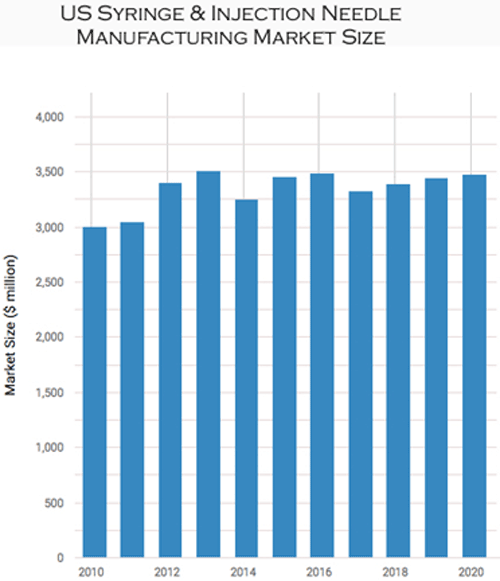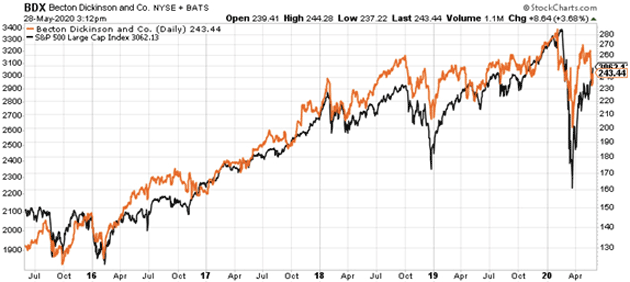The COVID Vaccine Side Effect Only One Company Knows How to Prevent By Dawn Pennington & Kevin Brekke | Jun 02, 2020 The race is on to find a vaccine for the coronavirus. Some of the world’s best companies and brightest scientific minds are working overtime to develop, test, and bring to market a safe and effective immunity to the virus. When that might happen is just a guess at this point. But many in the healthcare and scientific community are confident that a vaccine will be ready within the next 12 to 18 months. What we do know is that some 49% of Americans plan to get the SARS-CoV-2 vaccine. But getting one as soon as it is available is far from guaranteed. That’s because—when a vaccine does eventually roll out, and a national immunization program kicks off—it raises a big challenge. A Math Problem Between 100 million and 200 million Americans will likely get immunized against COVID-19. If each person receives a single shot, it will require an equal number of syringes, plungers, needles, and vials to administer the vaccine. If a dosing regimen of two shots is needed—which the Mayo Clinic thinks is likely—that would double the number of injection units needed to upward of 400 million… and potentially a lot more. A sudden spike of that magnitude in the demand for syringes and needles will put a huge strain on manufacturers. And the possibility of a shortage of syringes and needles has already grabbed the attention of the federal government, the healthcare industry, and medical equipment manufacturers. The Needle in the Supply Chain Haystack The US faced a similar situation during the 2004 flu epidemic. And one company played a pivotal role in meeting the demand for syringes and needles—Becton, Dickinson & Co. (BDX). This medical technology company was started in 1897 and built the first US plant that made nothing but syringes and injection needles in 1906. Today, this New Jersey-based firm is the largest maker of syringes and needles in the world, and the biggest in the US. In early May, the CEO of BD warned that there won’t be enough capacity to produce the number of syringes needed in the US if a coronavirus vaccine is developed. The company is engaged in “active conversations” with the federal government on how to get prepared once a vaccine is ready. Peter Navarro, the White House director of trade and manufacturing policy, added urgency to the call for action when he estimated that the US will need 850 million syringes to deliver a vaccine. That figure doesn’t even include the supplies needed to deliver flu shots, which should see a surge thanks to pharmacies increasing their orders. With a Little Help from Our Local Friends In normal times, the US could fill any supply gap with imports from foreign suppliers. But these aren’t normal times. Since the onset of the pandemic, 86 countries have either banned or restricted the export of medical equipment, according to the Global Trade Alert. 
Source: Global Trade Alert So the US will likely be forced to rely on domestic producers to meet the impending demand for vaccine delivery. Becton Dickinson will be a big part of the solution, and its sales of syringes, injection needles, stoppers, plungers, and vials should see big growth over the next one to two years. 
Source: IBIS World This segment of the medical device industry earns about $3.5 billion in annual sales. Before the pandemic, sales growth in this segment was forecast to be about 1.2% in 2020. The new reality is that sales will grow many times faster than the number projected just three months ago with a coronavirus vaccine on the horizon. 
Source: StockCharts Over the last five years, BDX stock (orange line) has consistently outperformed the S&P 500 (black line). This year’s market crash, however, has put the five-year performance of BDX in line with the broad market indexes. The latest repricing has put BDX on the radar of hedge funds, and their holdings of BDX have never been this high, according to recent findings at Insider Monkey. Becton, Dickinson & Co. looks like a strategic short-term play on the unfolding dynamics in the coronavirus vaccine story, and a solid intermediate-term investment in a global titan in the medical device industry. If you would like more “healthy” investing ideas like this one, we’d love to hear from you. Click here to send us an email. Parting Thoughts This moment in time is unlike any other in recent history. Change is happening faster than ever. All the news can get overwhelming, so thank you for making Reality Check part of your required reading. Now, let’s look at some other stories you might have missed… - We hit peak social distancing: That’s what you can take away from the Dallas Fed’s new Social Distancing Index. Geolocation data collected from mobile phones suggests that, since the end of March, we’re going out more and staying out longer—including to work.
- Another giant leap for mankind: SpaceX’s reusable Crew Dragon capsule landed safely at the International Space Station, some 220 miles above earth, Sunday morning. We, as a world, needed this kind of moment right now, as John Mauldin wrote over the weekend. And tomorrow in The Weekly Profit, Robert Ross will show you how you can invest in in this exciting, well, space. Watch your inbox at 10 a.m. for that, or sign up here to receive Robert’s free newsletter.
As always, we enjoy hearing from you. What’s on your mind? Tell us here. Until next week… |  | | Dawn Pennington
Co-editor, Reality Check |
|  | | Kevin Brekke
Co-editor, Reality Check |
|
   | | Share Your Thoughts on This Article | | |
| 